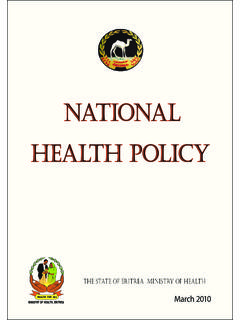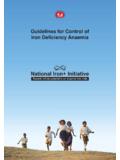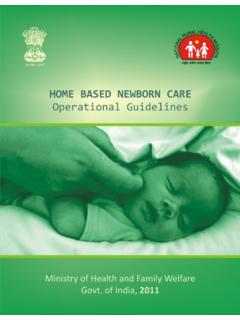Transcription of Maternal and Child Undernutrition 3 What works ...
1 41 Maternal and Child Undernutrition 3 What works ? interventions for Maternal and Child Undernutrition and survivalZulfiqar A Bhutta, Tahmeed Ahmed, Robert E Black, Simon Cousens, Kathryn Dewey, Elsa Giugliani, Batool A Haider, Betty Kirkwood, Saul S Morris, H P S Sachdev, Meera Shekar, for the Maternal and Child Undernutrition Study Group*We reviewed interventions that affect Maternal and Child Undernutrition and nutrition-related outcomes. These interventions included promotion of breastfeeding; strategies to promote complementary feeding, with or without provision of food supplements; micronutrient interventions ; general supportive strategies to improve family and community nutrition; and reduction of disease burden (promotion of handwashing and strategies to reduce the burden of malaria in pregnancy).
2 We showed that although strategies for breastfeeding promotion have a large effect on survival, their effect on stunting is small. In populations with sufficient food, education about complementary feeding increased height-for-age Z score by 0 25 (95% CI 0 01 0 49), whereas provision of food supplements (with or without education) in populations with insufficient food increased the height-for-age Z score by 0 41 (0 05 0 76). Management of severe acute malnutrition according to WHO guidelines reduced the case-fatality rate by 55% (risk ratio 0 45, 0 32 0 62), and recent studies suggest that newer commodities, such as ready-to-use therapeutic foods, can be used to manage severe acute malnutrition in community settings. Effective micronutrient interventions for pregnant women included supplementation with iron folate (which increased haemoglobin at term by 12 g/L, 2 93 21 07) and micronutrients (which reduced the risk of low birthweight at term by 16% (relative risk 0 84, 0 74 0 95).)
3 Recommended micronutrient interventions for children included strategies for supplementation of vitamin A (in the neonatal period and late infancy), preventive zinc supplements, iron supplements for children in areas where malaria is not endemic, and universal promotion of iodised salt. We used a cohort model to assess the potential effect of these interventions on mothers and children in the 36 countries that have 90% of children with stunted linear growth. The model showed that existing interventions that were designed to improve nutrition and prevent related disease could reduce stunting at 36 months by 36%; mortality between birth and 36 months by about 25%; and disability-adjusted life-years associated with stunting, severe wasting, intrauterine growth restriction, and micronutrient deficiencies by about 25%.
4 To eliminate stunting in the longer term, these interventions should be supplemented by improvements in the underlying determinants of Undernutrition , such as poverty, poor education, disease burden, and lack of women s an estimated 178 million children aged younger than 5 years who are stunted (ie, have a height-for-age Z score of less than 2),1 most live in sub-Saharan Africa and south-central Asia. 160 million (90%) stunted children live in just 36 countries, and make up 46% of the 348 million children in those countries. About 55 million children are wasted (ie, have a weight-for-height Z score of less than 2), of whom 19 million have severe wasting (weight-for-height Z score of less than 3) or severe acute malnutrition (weight-for-height Z score of 3 or lower or associated oedema).
5 Although the prevalence of Maternal Undernutrition assessed by low body-mass index varies, fetal Undernutrition or intrauterine growth restriction is common, with the highest prevalence in south-central The association between Undernutrition and Child mortality is strong,2 but evidence for the contribution of intrauterine growth restriction to mortality of neonates and children younger than 5 years has been less Published Online January 17, 2008 (07)61693-6 This is the third in a Series of five papers about Maternal and Child Undernutrition *Members listed at end of paperAga Khan University, Karachi, Pakistan (Prof Z A Bhutta PhD, B A Haider MD); Center for Health and Population Research, Dhaka, Bangladesh (T Ahmed PhD); Johns Hopkins Bloomberg School of Public Health, Baltimore, MD, USA (Prof R E Black MD); London School of Hygiene and Tropical Medicine, London, UK (Prof S Cousens PhD, Prof B Kirkwood PhD, S S Morris PhD); University of California, Davis, CA, USA (Prof K Dewey PhD); Federal University of Rio Grande de Sul, Porto Alegre, Brazil (E Giugliani); Sitaram Bhartia Institute of Science and Research, New Delhi, India (Prof H P S Sachdev); and World Bank, Washington DC, USA (M Shekar PhD) Correspondence to: Prof Zulfiqar A Bhutta, Department of Paediatrics and Child Health, Aga Khan University, Karachi, Pakistan messages Effective interventions are available to reduce stunting, micronutrient deficiencies, and Child deaths.
6 If implemented at sufficient scale, they would reduce DALYs (all Child deaths) by about a quarter in the short term Of available interventions , counselling about breastfeeding and fortification or supplementation with vitamin A and zinc have the greatest potential to reduce the burden of Child morbidity and mortality Improvement of complementary feeding through strategies such as counselling about nutrition for food-secure populations and nutrition counselling, food supplements, conditional cash transfers, or a combination of these, in food-insecure populations could substantially reduce stunting and related burden of disease interventions for Maternal nutrition (supplements of iron folate, multiple micronutrients, calcium, and balanced energy and protein)
7 Can improve outcomes for Maternal health and births, but few have been assessed at sufficient scale Although available interventions can make a clear difference in the short term, elimination of stunting will also require long-term investments to improve education, economic status, and empowerment of womenSeriesSeries42 We have therefore aimed in this Series1 to estimate the effects of Undernutrition , including intrauterine growth restriction, on childhood death and disability outcomes. We have also investigated the effects of intrauterine growth restriction and patterns of growth in early childhood on disease and human capital in addition to these anthropometric measures of Undernutrition , globally 10% of deaths and disability-adjusted life-years (DALYs) in children younger than 5 years are attributable to micronutrient deficiencies, with nearly all this burden due to deficiencies of vitamin A and zinc.
8 These calculations incorporate the documented effects of Undernutrition on Maternal and Child mortality and morbidity, but do not include the possible contribution of intrauterine growth restriction or altered growth in early childhood to obesity and non-communicable diseases in aimed to estimate the reduction in deaths related to stunting and lost DALYs that could result from implementation of interventions in the 36 countries in which 90% of the world s stunted children live. We also estimated the effects of these interventions on Maternal deaths and DALYs in the same countries. We reviewed all nutrition-related interventions that could affect selected nutritional outcomes or survival in mothers and children, and used a cohort model to determine the potential effect of delivering the selected interventions at high coverage to populations in need in these 36 selected interventions on the basis of the conceptual framework outlined in the first paper in this We excluded several important interventions that might have broad and long-term benefits, such as education, untargeted economic strategies or those for poverty alleviation, agricultural modifications, farming subsidies, structural adjustments, social and political changes, and land reform.
9 Although the well-known associations between humanitarian emergencies, conflict and population displacement, and undernutrition5 underlie the burden of Undernutrition in some of the 36 countries, we aimed to discuss possible intervention effects in Search strategy and selection criteriaEstimates of the efficacy or effectiveness of interventions either were taken from the most recent meta-analysis, or were calculated by the authors. We searched for both published and unpublished literature. We searched electronic reference libraries including the Cochrane library, ExtraMed, WHO Reproductive Health Library, Food and Nutrition Library, and PubMed. To retrieve reports of controlled trials, we searched for: (randomized controlled trial [pt] OR controlled clinical trial [pt] OR randomized controlled trials [mh] OR random allocation [mh] OR double-blind method [mh] OR single-blind method [mh] OR clinical trial [pt] OR clinical trials [mh] OR ( clinical trial [tw]) OR ((singl* [tw] OR doubl* [tw] OR trebl* [tw] OR tripl* [tw]) AND (mask* [tw] OR blind* [tw])) OR ( latin square [tw]) OR placebos [mh] OR placebo* [tw] OR random* [tw] OR research design [mh:noexp] OR comparative study [mh] OR evaluation studies [mh] OR follow-up studies [mh] OR prospective studies [mh] OR cross-over studies [mh] OR control* [tw] OR prospectiv* [tw] OR volunteer* [tw]) NOT (animal [mh] NOT human [mh]).
10 We reviewed evidence from randomised controlled trials, where available, but supplemented these with non-randomised and observational studies. Review groups assessed each study on a standardised rating scale according to its study design, size, execution, and data We identified unpublished literature by contacting experts and agencies that work on Undernutrition and searching available information on agency websites. We also included studies from the bibliographies of retrieved different reviewers independently rated large-scale nutrition programmes. Criteria included external assessment of the programme, adequacy of the description of the intervention and its implementation, presentation of methods in sufficient detail, appropriateness of the assessment design for the nature of the intervention, adequacy of the sample size, and appropriateness of the statistical analyses for the type of outcome measures and clustering.














